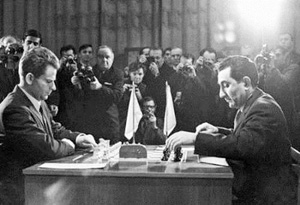After the controversy regarding the „Russian pact“ in the previous edition of the Candidates tournament, FIDE decided to change the format of the 1963-1966 World Championship qualifying cycle. Instead of the all-play-all tournament, Candidates knock-out matches were introduced for the first time in the history.
The cycle started with the customary Zonal Tournaments. Compared to the previous cycle, another Zone was added, increasing the total number to 10. 24 players from the Zonal tournaments qualified for the Interzonal tournament, held in Amsterdam in 1964. Of the strongest players in the world, only Fischer was absent, who, despite winning the Zonal 1963/1964 US Championship in tremendous fashion (11/11), refused to participate.
The Interzonal tournament was dominated by Soviet players. First six places winners were Smyslov, Larsen, Spassky, Tal, Stein and Bronstein. Alas, due to the rule restricting the number of the players from the same country to three, Stein and Bronstein weren’t allowed through. Borislav Ivkov and the winner of the Reshevsky – Portisch mini-match became the candidates instead. The afore-mentioned six, together with Mikhail Botvinnik (the loser of the 1963 match) and Paul Keres (second in the 1962 Candidates) formed the final line-up. When Botvinnik declined his invitation, Efim Geller, 3rd place winner in the 1962 Candidates, was seeded directly instead.
The Candidates matches were held during 1965. After beating Keres, Geller and Tal quite convincingly, Spassky qualified for the World Championship final and a match against Petrosian.
The match started in Moscow on April 9, 1966. Before the match, most of the people thought Petrosian has no equal in positional play and that tactical positions are his weak spot. Apparently, Spassky was of the similar opinion. His match tactics consisted of playing offbeat, objectively dubious, opening systems, in hope of creating tactical complications and outplaying Petrosian in an irrational struggle.
Such an approach completely backfired. In the first 12 games, Petrosian scored two victories, was winning in several other games and dictated the course of the match. He fully took advantage of Spassky’s dubious positions and with numerous exchange sacrifices (Petrosian’s patent)
frustrated his opponent. In the second part of the match, Spassky altered his approach and started
playing “normal” openings. After his wins in 13th and 19th games, it seemed he is back in the match. But Petrosian immediately struck back in the 20th game. By building upon his success, he clinched the match and defended his title.
Petrosian’s victory was fully deserved, as the words of the main arbiter O’Kelly testify:
„Petrosian’s superiority was felt throughout those two months. There were few theoretical improvements since the challenger did not follow the trodden path. Spassky very often violated the principles and laws of theory and paid dearly for it. Many people are disappointed with Spassky’s play. At times he was overcautious, sometimes too reckless, but the “Iron Tigran” never gave his adversary any chance of success. Spassky’s performance surprised some leading GM’s, who thought he would do much better. The outcome, however, was decided’ by Petrosian’s greater experience. Spassky is a talented player, but has little experience and is too young. But he will show his worth at some future time.“
Spassky himself commented he considered Petrosian as „first and foremost, a stupendous tactician“. However, he clearly drew his lessons from this match. He only had to wait another three years to demonstrate it.
Sources:
Chessgames: Petrosian – Spassky, 1966
Chesspedia: Petrosian – Spassky, 1966
Wikipedia: World Chess Championship 1966

